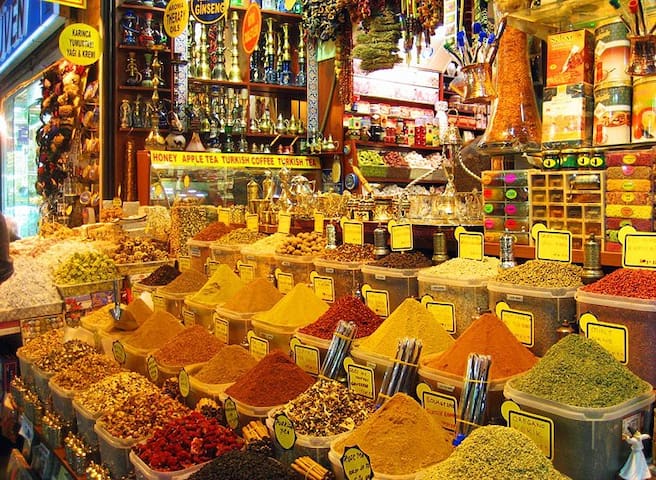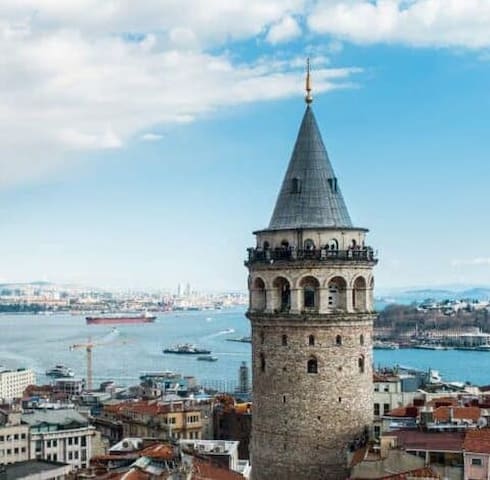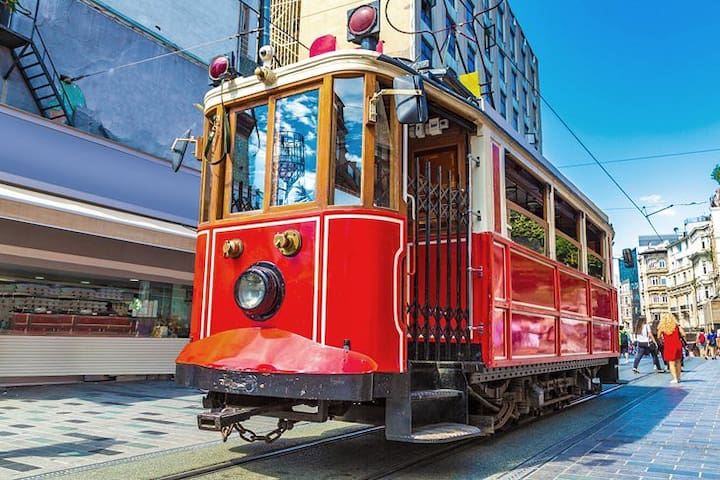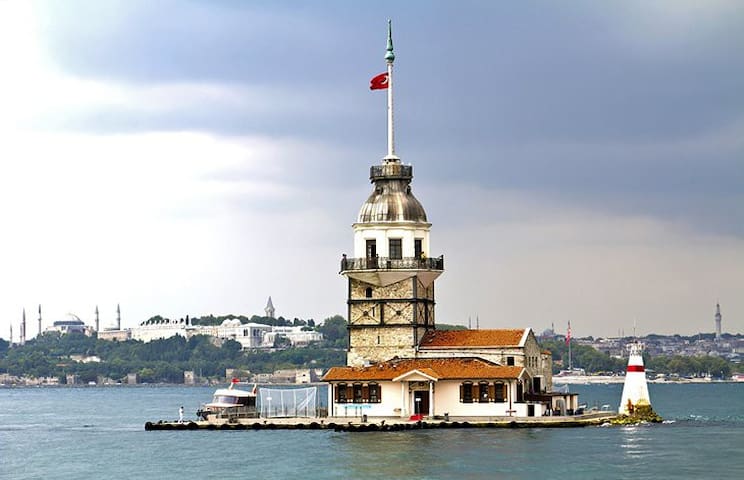Sightseeing
It's said that when the Byzantine Emperor Justinian entered his finished church for the first time in CE 536, he cried out "Glory to God that I have been judged worthy of such a work. Oh Solomon, I have outdone you!"
Official site: https://muze.gen.tr/muze-detay/ayasofya
1014 locals recommend
Hagia Sophia
No:1 Ayasofya MeydanıIt's said that when the Byzantine Emperor Justinian entered his finished church for the first time in CE 536, he cried out "Glory to God that I have been judged worthy of such a work. Oh Solomon, I have outdone you!"
Official site: https://muze.gen.tr/muze-detay/ayasofya
The Basilica Cistern is one of Istanbul's most surprising tourist attractions.
This huge, palace-like underground hall, supported by 336 columns in 12 rows, once stored the imperial water supply for the Byzantine emperors.
The project was begun by Constantine the Great but finished by Emperor Justinian in the 6th century.
Many of the columns used in construction were recycled from earlier classical structures and feature decorative carvings.
The most famous of these are the column bases known as the Medusa stones in the northwest corner with their Medusa head carvings.
A visit here is very atmospheric with the columns beautifully lit and the soft, steady trickle of water all around you.
Address: Yerebatan Caddesi, Sultanahmet
Official site: https://www.yerebatan.com/en
638 locals recommend
Basilica Cistern
1/3 Yerebatan Cd.The Basilica Cistern is one of Istanbul's most surprising tourist attractions.
This huge, palace-like underground hall, supported by 336 columns in 12 rows, once stored the imperial water supply for the Byzantine emperors.
The project was begun by Constantine the Great but finished by Emperor Justinian in the 6th century.
Many of the columns used in construction were recycled from earlier classical structures and feature decorative carvings.
The most famous of these are the column bases known as the Medusa stones in the northwest corner with their Medusa head carvings.
A visit here is very atmospheric with the columns beautifully lit and the soft, steady trickle of water all around you.
Address: Yerebatan Caddesi, Sultanahmet
Official site: https://www.yerebatan.com/en
Just a hop, skip, and jump away from Topkapı Palace, and easily visited afterwards, this important museum complex brings together an array of artifacts from both Turkey and throughout the Middle East, which sweeps through the vast breadth of history of this region.
179 locals recommend
Istanbul Archaeological Museum
Just a hop, skip, and jump away from Topkapı Palace, and easily visited afterwards, this important museum complex brings together an array of artifacts from both Turkey and throughout the Middle East, which sweeps through the vast breadth of history of this region.
For many visitors, sightseeing in Istanbul is as much about shopping as museums and monumental attractions, and the Grand Bazaar is where everyone comes.
This massive covered market is basically the world's first shopping mall, taking up a whole city quarter, surrounded by thick walls, between the Nuruosmanıye Mosque and Beyazıt Mosque.
The Beyazıt Mosque (built in 1498-1505) itself occupies the site of Theodosius I's Forum and has architecture inspired by the Hagia Sophia.
Entrance to the bazaar is through one of 11 gates from where a maze of vaulted-ceiling laneways, lined by shops and stalls selling every Turkish souvenir and handicraft you could imagine, cover the area.
The various trades are still mostly segregated into particular sections, which makes browsing easier.
Near the bazaar's Divanyolu Caddesi entrance is the Burned Column. This stump (still 40 meters high) of a porphyry column was set up by Constantine the Great in his forum. Until 1105, it bore a bronze statue of Constantine.
Address: Divanyolu Caddesi
810 locals recommend
Grand Bazaar
Beyazıt CaddesiFor many visitors, sightseeing in Istanbul is as much about shopping as museums and monumental attractions, and the Grand Bazaar is where everyone comes.
This massive covered market is basically the world's first shopping mall, taking up a whole city quarter, surrounded by thick walls, between the Nuruosmanıye Mosque and Beyazıt Mosque.
The Beyazıt Mosque (built in 1498-1505) itself occupies the site of Theodosius I's Forum and has architecture inspired by the Hagia Sophia.
Entrance to the bazaar is through one of 11 gates from where a maze of vaulted-ceiling laneways, lined by shops and stalls selling every Turkish souvenir and handicraft you could imagine, cover the area.
The various trades are still mostly segregated into particular sections, which makes browsing easier.
Near the bazaar's Divanyolu Caddesi entrance is the Burned Column. This stump (still 40 meters high) of a porphyry column was set up by Constantine the Great in his forum. Until 1105, it bore a bronze statue of Constantine.
Address: Divanyolu Caddesi
The Spice Bazaar is the place to get your foodie fix of lokum (Turkish delight), dried fruit, nuts, herbs, and, of course, spices.
Much of the money that helped construct it came from the taxes the Ottoman government levied on Egyptian-made products, which is why its name in Turkish (Mısır Çarşısı) means "Egyptian Market."
The Spice Bazaar is one of Istanbul's most popular tourist attractions and at certain times of the day gets ridiculously crowded with huge tour groups from the docked cruise ships.
Try to come before 11am or after 4pm to dodge the crowds.
Just next door to the Spice Bazaar's main entrance is the stately Yeni Cami (New Mosque), which was begun in 1615 and finished in 1663 – that's "new" for Istanbul.
It is worthwhile taking a peek inside while you're sightseeing in the area, as the interior is richly decorated with tilework and liberal use of gold leaf.
Address: Yenicami Meydanı, Eminönü
449 locals recommend
Spice Bazaar
92 Erzak Ambarı Sok.The Spice Bazaar is the place to get your foodie fix of lokum (Turkish delight), dried fruit, nuts, herbs, and, of course, spices.
Much of the money that helped construct it came from the taxes the Ottoman government levied on Egyptian-made products, which is why its name in Turkish (Mısır Çarşısı) means "Egyptian Market."
The Spice Bazaar is one of Istanbul's most popular tourist attractions and at certain times of the day gets ridiculously crowded with huge tour groups from the docked cruise ships.
Try to come before 11am or after 4pm to dodge the crowds.
Just next door to the Spice Bazaar's main entrance is the stately Yeni Cami (New Mosque), which was begun in 1615 and finished in 1663 – that's "new" for Istanbul.
It is worthwhile taking a peek inside while you're sightseeing in the area, as the interior is richly decorated with tilework and liberal use of gold leaf.
Address: Yenicami Meydanı, Eminönü
The sumptuous and ornate Dolmabahçe Palace shows the clear influence of European decoration and architecture on the Ottoman Empire in the 19th century.
Built by Sultan Abdülmecid I in 1854, it replaced Topkapı Palace as the main residence of the sultans.
Dolmabahçe Palace was also used as an official residence during the founding years of the Turkish Republic, and Atatürk (the founder of modern Turkey) died here in 1938.
The formal gardens are punctuated with fountains, ornamental basins, and blooming flower beds.
Inside, the interiors blend Rococo, Baroque, Neoclassical and Ottoman elements with mammoth crystal chandeliers, liberal use of gold, French-style furnishings, and frescoed ceilings to create a dazzling Turkish Renaissance style of sheer splendor and pomp.
Location: Dolmabahçe Caddesi, Besiktas
Official site: http://www.millisaraylar.gov.tr/
580 locals recommend
Dolmabahce Palace
Dolmabahçe CaddesiThe sumptuous and ornate Dolmabahçe Palace shows the clear influence of European decoration and architecture on the Ottoman Empire in the 19th century.
Built by Sultan Abdülmecid I in 1854, it replaced Topkapı Palace as the main residence of the sultans.
Dolmabahçe Palace was also used as an official residence during the founding years of the Turkish Republic, and Atatürk (the founder of modern Turkey) died here in 1938.
The formal gardens are punctuated with fountains, ornamental basins, and blooming flower beds.
Inside, the interiors blend Rococo, Baroque, Neoclassical and Ottoman elements with mammoth crystal chandeliers, liberal use of gold, French-style furnishings, and frescoed ceilings to create a dazzling Turkish Renaissance style of sheer splendor and pomp.
Location: Dolmabahçe Caddesi, Besiktas
Official site: http://www.millisaraylar.gov.tr/
Chora means "country" in Greek, and this beautiful Church (originally called the Church of St. Saviour of Chora) lay just outside old Constantinople's city walls.
The first Chora Church was probably built here in the 5th century, but what you see now is the building's 6th reconstruction as it was destroyed completely in the 9th century and went through several facelifts from the 11th to 14th centuries.
The church was turned into a mosque after the Ottoman conquest of Constantinople and became a museum in 1945. In 2020, it reconverted into a working mosque.
The monument is rightly world-famous for its fabulously vibrant 14th-century mosaics, preserved almost intact in the two narthexes and fragmentarily in the nave, and the frescos along the walls and domes.
These incredible examples of Byzantine artistry cover a wide range of themes, from the genealogy of Christ to the New Testament stories.
Location: Kariye Cami Sokak, Edirnekapı
142 locals recommend
Chora Museum
18 Kariye Cami Sk.Chora means "country" in Greek, and this beautiful Church (originally called the Church of St. Saviour of Chora) lay just outside old Constantinople's city walls.
The first Chora Church was probably built here in the 5th century, but what you see now is the building's 6th reconstruction as it was destroyed completely in the 9th century and went through several facelifts from the 11th to 14th centuries.
The church was turned into a mosque after the Ottoman conquest of Constantinople and became a museum in 1945. In 2020, it reconverted into a working mosque.
The monument is rightly world-famous for its fabulously vibrant 14th-century mosaics, preserved almost intact in the two narthexes and fragmentarily in the nave, and the frescos along the walls and domes.
These incredible examples of Byzantine artistry cover a wide range of themes, from the genealogy of Christ to the New Testament stories.
Location: Kariye Cami Sokak, Edirnekapı
Housed in the palace of Ibrahim Paşa, who was Grand Vizier for Sultan Süleyman the Magnificent, this museum is a must-see attraction for anyone interested in Ottoman and Islamic art.
The carpet collection on display here is vast and is heralded by textile experts as the world's best.
This is a prime place to come have a peek at the dazzling array of styles of Turkish carpets (along with carpets from the Caucasus and Iran) across the centuries before setting out on a shopping mission to purchase your own floor piece.
There are also exquisite ceramics, calligraphy, and wood carving exhibits ranging in date from the 9th century CE to the 19th century.
Address: At Meydanı Caddesi, Sultanahmet
Official site: https://muze.gen.tr/muze-detay/tiem
65 locals recommend
Ibrahim Pasha Palace Museum of Turkish and Islamic Arts
44 Atmeydanı Cd.Housed in the palace of Ibrahim Paşa, who was Grand Vizier for Sultan Süleyman the Magnificent, this museum is a must-see attraction for anyone interested in Ottoman and Islamic art.
The carpet collection on display here is vast and is heralded by textile experts as the world's best.
This is a prime place to come have a peek at the dazzling array of styles of Turkish carpets (along with carpets from the Caucasus and Iran) across the centuries before setting out on a shopping mission to purchase your own floor piece.
There are also exquisite ceramics, calligraphy, and wood carving exhibits ranging in date from the 9th century CE to the 19th century.
Address: At Meydanı Caddesi, Sultanahmet
Official site: https://muze.gen.tr/muze-detay/tiem
Before Emperor Justinian built the Hagia Sofia (Aya Sofya), he had to test out if the building would work structurally, so he built this miniature version first.
Its original name was the Church of Sergius and Bacchus, but the obvious architectural parallels with the Aya Sofya led to its long-held nickname becoming the building's official title.
During the Ottoman era, the church was converted into a mosque and it still functions as a working mosque today.
Although its proportions aren't as grandiose as others in Istanbul, the building has been beautifully restored and is well worth a visit.
The walk here, down narrow alleyways lined with tall Ottoman era buildings – some lavishly restored and others creaking their way into dilapidation – is a tranquil respite from central Sultanahmet.
Take the time to have a glass of tea in the Little Aya Sofya's peaceful garden to sustain you for further sightseeing exploits.
Address: Küçük Aya Sofya Caddesi , Sultanahmet
63 locals recommend
Little Hagia Sophia
No:20 Küçük Ayasofya Camii SokagiBefore Emperor Justinian built the Hagia Sofia (Aya Sofya), he had to test out if the building would work structurally, so he built this miniature version first.
Its original name was the Church of Sergius and Bacchus, but the obvious architectural parallels with the Aya Sofya led to its long-held nickname becoming the building's official title.
During the Ottoman era, the church was converted into a mosque and it still functions as a working mosque today.
Although its proportions aren't as grandiose as others in Istanbul, the building has been beautifully restored and is well worth a visit.
The walk here, down narrow alleyways lined with tall Ottoman era buildings – some lavishly restored and others creaking their way into dilapidation – is a tranquil respite from central Sultanahmet.
Take the time to have a glass of tea in the Little Aya Sofya's peaceful garden to sustain you for further sightseeing exploits.
Address: Küçük Aya Sofya Caddesi , Sultanahmet
Although it's a bit of a schlep on the suburban train to get out to Yedikule (Castle of the Seven Towers), this commanding fortress is well worth it.
Built in the 5th century by the Emperor Theodosius II, the fortress made up the southern section of Constantinople's defensive walls.
The mammoth arch (blocked up in the late Byzantine period) was known as Porta Aurea (Golden Gate), with doors plated in gold.
When the Ottomans conquered the city, they used the fortress for defense, and later as a prison and execution place.
Yedikule has been restored in recent years, and you can climb up to the top of the battlements for superb views across the Sea of Marmara.
Address: Yedikule Sokak, Yedikule
19 locals recommend
Yedikule Dungeons Museum
No:9 Yedikule Meydanı Sk.Although it's a bit of a schlep on the suburban train to get out to Yedikule (Castle of the Seven Towers), this commanding fortress is well worth it.
Built in the 5th century by the Emperor Theodosius II, the fortress made up the southern section of Constantinople's defensive walls.
The mammoth arch (blocked up in the late Byzantine period) was known as Porta Aurea (Golden Gate), with doors plated in gold.
When the Ottomans conquered the city, they used the fortress for defense, and later as a prison and execution place.
Yedikule has been restored in recent years, and you can climb up to the top of the battlements for superb views across the Sea of Marmara.
Address: Yedikule Sokak, Yedikule
This tower overlooking the Golden Horn was built by the Genoese in the 14th century. Today it remains one of Istanbul's most recognizable landmarks.
Standing 52 meters tall, the tower was Istanbul's tallest building for centuries. The tower has been restored several times over the years due to being damaged by fire and storms.
Today the observation deck at the top story, and its restaurant, is one of the best places to visit in Istanbul for taking in the iconic skyline views of the central old city.
Be aware, though, that it's a super popular sight, so come early or be prepared to queue.
Address: Bereketzade, Beyoğlu
Official site: https://muze.gen.tr/muze-detay/galatakulesi
1235 locals recommend
Galata Tower
This tower overlooking the Golden Horn was built by the Genoese in the 14th century. Today it remains one of Istanbul's most recognizable landmarks.
Standing 52 meters tall, the tower was Istanbul's tallest building for centuries. The tower has been restored several times over the years due to being damaged by fire and storms.
Today the observation deck at the top story, and its restaurant, is one of the best places to visit in Istanbul for taking in the iconic skyline views of the central old city.
Be aware, though, that it's a super popular sight, so come early or be prepared to queue.
Address: Bereketzade, Beyoğlu
Official site: https://muze.gen.tr/muze-detay/galatakulesi
Cruise the Bosphorus Strait
For many visitors, a trip to Istanbul isn't complete without hopping aboard a Bosphorus excursion ferry and cruising the city's famed waterway, which connects the Black Sea to the Sea of Marmara.
Istanbul's most iconic views are all from the water, and the Bosphorus excursion ferries are all about sitting back, relaxing, and taking in the scenery.
The most famous ferry tour is the Long Bosphorus Tour, which heads from Eminönü ferry dock daily, all the way up the strait to the village and fortress at Anadolu Kavağı, near the northern mouth of the strait into the Black Sea.
Along the ferry cruise there are shoreside vistas of defensive fortresses, Ottoman-era palaces and mansions, and the Bosphorus' bridges.
The Long Bosphorus Tour takes two hours one-way, stops in Anadolu Kavağı for three hours, and then returns, so you need to set aside a full day of your itinerary if you want to do it.
There is also a Short Bosphorus Tour option that operates daily two-hour afternoon sailings from spring to fall. This return ferry cruise heads up the Bosphorus as far as Rumeli fortress before turning around.
28 locals recommend
Eminönü İskele
Cruise the Bosphorus Strait
For many visitors, a trip to Istanbul isn't complete without hopping aboard a Bosphorus excursion ferry and cruising the city's famed waterway, which connects the Black Sea to the Sea of Marmara.
Istanbul's most iconic views are all from the water, and the Bosphorus excursion ferries are all about sitting back, relaxing, and taking in the scenery.
The most famous ferry tour is the Long Bosphorus Tour, which heads from Eminönü ferry dock daily, all the way up the strait to the village and fortress at Anadolu Kavağı, near the northern mouth of the strait into the Black Sea.
Along the ferry cruise there are shoreside vistas of defensive fortresses, Ottoman-era palaces and mansions, and the Bosphorus' bridges.
The Long Bosphorus Tour takes two hours one-way, stops in Anadolu Kavağı for three hours, and then returns, so you need to set aside a full day of your itinerary if you want to do it.
There is also a Short Bosphorus Tour option that operates daily two-hour afternoon sailings from spring to fall. This return ferry cruise heads up the Bosphorus as far as Rumeli fortress before turning around.
Take in the Art at Istanbul Modern
Proving that Istanbul isn't just about historic sightseeing, this thoroughly up-to-the-minute art gallery holds an extensive collection of Turkish modern art with an ever-changing calendar of exhibitions, hosting both local and international artists throughout the year.
This is by far the best place in town to get your finger on the pulse of Turkey's contemporary art scene.
As well as the galleries, the Istanbul Modern has a cinema that hosts a program of film viewings and a library.
The galleries are being temporarily hosted in a historic Beyoğlu building while they wait for the completion of this art museum's new permanent home in Karaköy.
Address: Mesrutiyet Caddesi, No:99, Beyoğlu (WALKING DIST)
618 locals recommend
Istanbul Museum of Modern Art
No:1/1 Meşrutiyet Cd.Take in the Art at Istanbul Modern
Proving that Istanbul isn't just about historic sightseeing, this thoroughly up-to-the-minute art gallery holds an extensive collection of Turkish modern art with an ever-changing calendar of exhibitions, hosting both local and international artists throughout the year.
This is by far the best place in town to get your finger on the pulse of Turkey's contemporary art scene.
As well as the galleries, the Istanbul Modern has a cinema that hosts a program of film viewings and a library.
The galleries are being temporarily hosted in a historic Beyoğlu building while they wait for the completion of this art museum's new permanent home in Karaköy.
Address: Mesrutiyet Caddesi, No:99, Beyoğlu (WALKING DIST)
Istiklal Caddesi
İstiklal CaddesiNeighborhoods
Istanbul's Asian shore is easily reached by ferry from Eminönü dock across the Bosphorus.
On an islet just off the Asiatic shore stands the 30-meter-high Kızkulesi (Maiden's Tower).
Üsküdar was traditionally known as Scutari and has some handsome old mosques, winding lanes, and weathered brown timber houses (particularly between the ferry dock and the large cemetery).
The town, known in antiquity as Chrysopolis, was one of the earliest Greek settlements on the Bosporus.
It was much more exposed to attack by foreign conquerors than Constantinople, with its defensive situation and strong walls, but it was able to draw economic advantage from its exposed situation – until 1800 it was the terminus of the caravan routes that brought the treasures of the East to Constantinople and onwards to Europe.
Of particular sightseeing interest here is the Atik Valide Mosque, which was designed by the famed Ottoman architect Sinan; and the Çinili Mosque, which contains some beautiful Iznik tilework.
113 locals recommend
Üsküdar
Istanbul's Asian shore is easily reached by ferry from Eminönü dock across the Bosphorus.
On an islet just off the Asiatic shore stands the 30-meter-high Kızkulesi (Maiden's Tower).
Üsküdar was traditionally known as Scutari and has some handsome old mosques, winding lanes, and weathered brown timber houses (particularly between the ferry dock and the large cemetery).
The town, known in antiquity as Chrysopolis, was one of the earliest Greek settlements on the Bosporus.
It was much more exposed to attack by foreign conquerors than Constantinople, with its defensive situation and strong walls, but it was able to draw economic advantage from its exposed situation – until 1800 it was the terminus of the caravan routes that brought the treasures of the East to Constantinople and onwards to Europe.
Of particular sightseeing interest here is the Atik Valide Mosque, which was designed by the famed Ottoman architect Sinan; and the Çinili Mosque, which contains some beautiful Iznik tilework.




